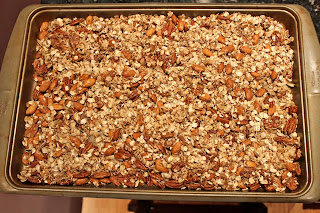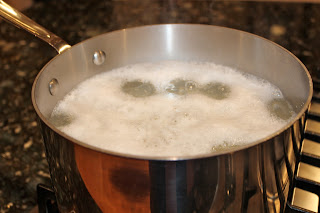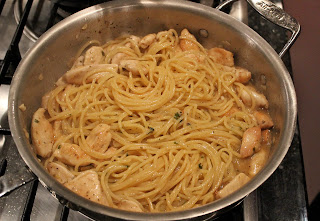I finally started my Christmas shopping this week, so haven't had so much time to cook. Steve and I shopped in downtown State College last week (Animal Kingdom and the Growing Tree), and then I hit the internet. In our family, we're big believers in the Amazon Wish List. Michael got us started because it suited his sense of practicality...you knew that people actually wanted what you were giving them. Some of us are better at populating our lists than others, but it does make the shopping part more efficient. One of the challenges of internet shopping is that in a world of (nearly) infinite possibilities, you feel that you have to check all of the options to be sure you got the best price on the exact item you want...and ideally free shipping. So it does take some time, and it's easy for hours to slip away. Hence, I'm going to post some quick and easy dinners that are ideal for weeknights or days when you don't want to spend much time in the kitchen.
This is a super easy, super fast kid-friendly main dish. I started making this for my kids probably 25 years ago. The recipe came from a women's magazine of some sort, and the original recipe was supposed to be "lite," which means I had to coax it into not only tasting good, but physically working. You can't really coat 1 1/4 lb of chicken with 2 Tablespoons of flour. And if you use 1 Tablespoon of butter and 1 Tablespoon of canola oil, your chicken will reliably stick to the bottom of the pan, requiring you to scrape it free and creating opportunities for charred remnants to be in your sauce. So you'll notice I've increased the amounts of both flour and fat. It works well with any type of pasta, and I've made it with gemelli, farfalle (bow ties), and when it was available, fresh cut egg spaghetti. All are good, so feel free to be creative. You can also vary the herbs. Here I used oregano and parsley, but you could use rosemary or tarragon if you like.
CHICKEN SCARPARIELLO
1 lb. cooked pasta of your choice
1 1/4 lb. skinless, boneless chicken breasts, cut into 1x3-inch strips
1/2 cup AP flour, more if needed
salt and pepper
4 Tablespoons each butter and canola oil, divided
4 Tablespoons minced shallots
4 cloves garlic, minced
1 cup dry white wine
2 cups chicken broth (I use Wegman's Chicken Culinary Stock)
1 teaspoon oregano
1 Tablespoon parsley
*How you handle proteins (chicken, beef, pork, fish, shrimp, etc.) is important. Do not wash it. After years of recommending washing, scientists now say that you risk spreading any bacteria on it to kitchen surfaces, which is more dangerous than simply cooking it. However, since most of us buy our meat and chicken in plastic wrapping, it always develops a certain amount of slimy moisture on the surface, so
do dry it with paper towels, otherwise it will not sear or caramelize when that moisture joins with the butter or oil in the pan. The point of searing is to seal in moisture by quickly heating the surface of the protein, creating a tasty crust. Now, if you are so fortunate to buy your proteins from a butcher who wraps them in paper, the surfaces will remain dry, but it must be used up within a day.
Cook pasta al dente (the minimum time on the package) because you will be finishing it in the sauce and it will cook a little more. While the pasta is cooking, place flour, salt and pepper in a shallow bowl, and dredge the chicken in it.
In a large skillet (I use my favorite All-Clad Esssential 6 qt pan because it has high sides, so when I add the pasta at the end I can mix it together without unattractive spill-over), combine 2 Tablespoons butter and 2 Tablespoons oil and heat over medium-high heat until butter is bubbly and hot; add half of the chicken
and cook, turning occasionally, until lightly browned on all sides, 3 or 4 minutes. Remove to a bowl with tongs.
Add the remaining butter and oil to the pan, and saute the other half of the chicken. Move it to the bowl with the rest of the chicken.
To the same skillet, add shallots and garlic and saute until softened, 1 minute;
add wine, letting it burn off slightly,
then add the chicken stock and seasonings, and stir well.
Cook stirring frequently, until liquid is reduced by half, 4 or 5 minutes longer. Return chicken to skillet, and cook until sauce is thick and chicken is heated through, 1 to 2 minutes.
Mix pasta in with chicken and stir until sauce is thoroughly incorporated with pasta and there is little liquid left in the bottom of the pan.
This method, mixing the pasta in with the sauce and heating them together, works well with most pasta dishes. It really infuses the pasta with flavor in a way that is not possible if you just pour the sauce over it.
Serves 4.
P.S. If you have leftovers, reheat them in a nonstick frying pan and crisp the noodles a little.



















































